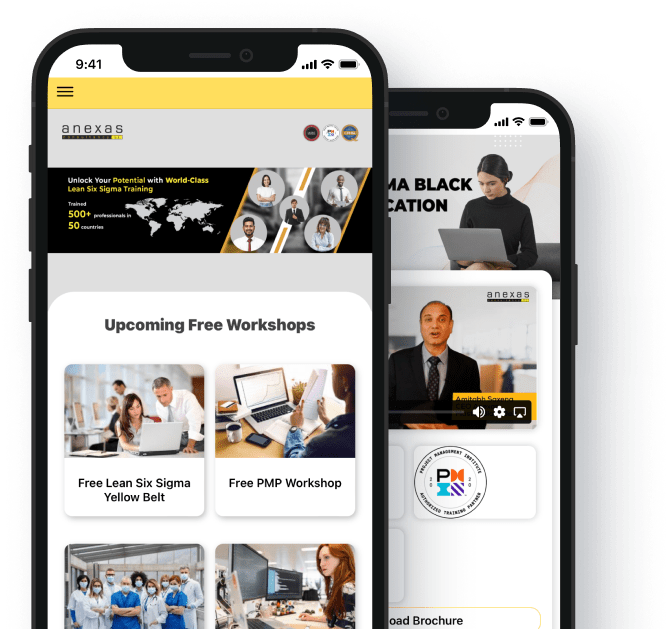Table of Contents
Share This Article
The Role of Leadership in Successful Lean Six Sigma Implementation
- 27916 views
Introduction to Lean Six Sigma
Brief overview of Lean Six Sigma
Lean Six Sigma represents a powerful amalgamation of two distinct but complementary methodologies: Lean Manufacturing and Six Sigma. At its core, it operates on the DMAIC framework – Define, Measure, Analyze, Improve, and Control. Lean principles, drawn from the Toyota Production System, focus on eliminating waste, enhancing flow, and ensuring value delivery to customers. On the other hand, Six Sigma relies on statistical methods to identify and reduce process variations, thereby improving overall quality. The integration of Lean and Six Sigma provides organizations with a comprehensive approach to process improvement, allowing them to systematically identify and eliminate inefficiencies while ensuring a data-driven and disciplined problem-solving approach.
Importance of Lean Six Sigma for businesses
The impact of Lean Six Sigma on businesses is profound, addressing critical aspects of efficiency, quality, and customer satisfaction. By systematically applying Lean Six Sigma principles, organizations can achieve cost reductions through waste elimination, optimize processes to enhance overall productivity, and significantly improve the quality of products or services. Beyond tangible benefits, the methodology fosters a culture of continuous improvement, empowering employees to actively participate in problem-solving initiatives. This cultural shift not only enhances employee engagement but also positions the organization to adapt more effectively to changing market conditions. In a nutshell, Lean Six Sigma is not merely a set of tools but a holistic approach that propels businesses toward sustainable growth, operational excellence, and a competitive edge in the contemporary business landscape.
Why Lean Six Sigma?
Key benefits of Lean Six Sigma
Cost reduction
Cost reduction is a cornerstone benefit of Lean Six Sigma, as it empowers organizations to identify and eliminate inefficiencies, redundancies, and unnecessary expenses throughout their processes. By employing the principles of Lean Six Sigma, businesses can streamline operations, optimize resource utilization, and cut down on excess inventory. Through systematic waste reduction and improved resource management, companies not only realize immediate cost savings but also establish a foundation for sustained financial efficiency. The methodology’s emphasis on data-driven decision-making ensures that cost reduction efforts are targeted and strategic, leading to long-term financial benefits.
Quality improvement
Lean Six Sigma is renowned for its commitment to enhancing product and service quality. The methodology employs statistical tools and rigorous analysis to identify and address the root causes of defects or errors in processes. This dedication to quality improvement not only reduces the occurrence of defects but also fosters a culture of continuous improvement. By consistently meeting or exceeding customer expectations, businesses not only enhance their reputation but also reduce costs associated with rework, warranty claims, and customer complaints. The result is a higher level of customer satisfaction, loyalty, and a competitive edge in the market.
Increased efficiency
Lean Six Sigma is synonymous with operational efficiency improvement. By scrutinizing processes and eliminating unnecessary steps or bottlenecks, organizations can achieve streamlined workflows and optimized resource utilization. This leads to increased efficiency in operations, reduced lead times, and a more responsive organization capable of adapting swiftly to changing market demands. Improved efficiency not only contributes to immediate gains in productivity but also positions businesses for long-term success by ensuring they stay agile and adaptable in a dynamic business environment.
Enhanced customer satisfaction
The culmination of cost reduction, quality improvement, and increased efficiency directly contributes to enhanced customer satisfaction. Lean Six Sigma focuses on aligning organizational processes with customer expectations, resulting in the consistent delivery of products or services that meet or exceed customer requirements. Actively seeking and incorporating customer feedback into improvement processes ensures a continuous cycle of refining products or services to meet evolving customer needs. The result is increased customer loyalty, positive word-of-mouth, and a reputation for delivering value, all of which are crucial for sustaining a competitive advantage in the market.

Leadership’s Crucial Role
Effective leadership is pivotal to the successful implementation of Lean Six Sigma, as it plays a central role in guiding organizations through the transformative journey of process improvement. In the context of Lean Six Sigma, leadership goes beyond traditional managerial roles; it involves inspiring a culture of continuous improvement, fostering collaboration, and championing the values of Lean and Six Sigma methodologies. Leadership serves as the driving force that aligns organizational objectives with the principles of Lean Six Sigma, ensuring that the entire workforce is engaged and committed to the pursuit of excellence.
- Defining leadership in Lean Six Sigma: In Lean Six Sigma, leadership extends beyond hierarchical positions to encompass individuals who actively promote and facilitate the principles of the methodology. It involves setting a clear vision, communicating the importance of Lean Six Sigma, and empowering teams to contribute to continuous improvement. Leaders in this context serve as change agents, driving the cultural shift necessary for successful Lean Six Sigma adoption.
- Traits of effective leaders in this context: Effective leaders in Lean Six Sigma exhibit specific traits crucial for navigating the challenges of process improvement. These include being visionary, possessing a deep commitment to the methodology, communicating effectively to inspire and guide teams, and providing unwavering support throughout the implementation journey. Leaders must also be adept at fostering a collaborative environment, encouraging creativity, and valuing data-driven decision-making. By embodying these traits, leaders create a foundation for successful Lean Six Sigma implementation within their organizations.
- Real-world examples of successful leadership in Lean Six Sigma: Examining real-world examples of successful leadership in Lean Six Sigma provides valuable insights into the practical application of these principles. Companies such as Toyota, General Electric, and Motorola stand out for their exemplary leadership in driving Lean Six Sigma initiatives. These organizations have leaders who championed the methodologies, actively engaged in process improvement efforts, and inspired a culture of continuous learning and adaptation. Through their leadership, these companies achieved significant improvements in quality, efficiency, and customer satisfaction, underscoring the transformative impact effective leadership can have in the realm of Lean Six Sigma implementation.
Challenges and Solutions
Successfully implementing Lean Six Sigma comes with its own set of challenges, requiring organizations to navigate obstacles effectively. Understanding these challenges and having strategies in place is crucial for ensuring a smooth adoption and reaping the benefits of the methodology.
Common obstacles in implementation
Common obstacles in implementing Lean Six Sigma include resistance to change, inadequate resources, and insufficient training. Resistance often arises due to a lack of understanding or fear of the unknown. Insufficient resources, both in terms of personnel and technology, can impede the effective execution of improvement initiatives. Additionally, without proper training, employees may struggle to embrace the methodology, hindering its successful integration into the organizational culture.
How effective leadership can overcome challenges
Effective leadership plays a pivotal role in overcoming these challenges. Leaders can address resistance to change by fostering a culture of open communication, providing clarity on the benefits of Lean Six Sigma, and actively involving employees in the process. Adequate resource allocation, guided by strategic decision-making, ensures that teams have the tools and personnel needed for success. Leaders also play a crucial role in ensuring that employees receive the necessary training and development opportunities to become proficient in Lean Six Sigma methodologies, fostering a sense of empowerment and confidence in the workforce.
Quick tips for mitigating common issues
- Communication is Key: Transparent and consistent communication helps alleviate fears and uncertainties associated with change. Leaders should communicate the purpose, benefits, and expected outcomes of Lean Six Sigma initiatives clearly.
- Strategic Resource Allocation: Leaders should strategically allocate resources, considering the specific needs of each improvement initiative. This ensures that teams have the necessary support and tools for successful implementation.
- Invest in Training: Providing comprehensive training programs equips employees with the knowledge and skills required for effective Lean Six Sigma participation. This investment in training pays off in terms of increased proficiency and confidence among the workforce.
- Continuous Support: Leadership must provide ongoing support throughout the implementation process, demonstrating commitment to the methodology. Regular check-ins, feedback sessions, and recognizing achievements contribute to a positive and supportive environment.

Case Studies for Inspiration
Examining success stories of companies that have effectively implemented Lean Six Sigma with strong leadership provides valuable insights and inspiration for organizations embarking on their improvement journeys. Companies like Toyota, General Electric, and Amazon stand out as exemplary cases where leadership played a pivotal role in the successful adoption of Lean Six Sigma. These organizations demonstrated visionary leadership, unwavering commitment to continuous improvement, and a culture that encourages employees at all levels to actively participate in the process. Through the implementation of Lean Six Sigma methodologies, these companies achieved significant improvements in operational efficiency, product quality, and customer satisfaction. Leaders in these success stories not only understood the principles of Lean Six Sigma but also actively championed them, fostering a culture where employees are empowered to contribute to the organization’s overall success.
Success stories of companies with strong leadership
Toyota, often regarded as the pioneer of Lean Manufacturing, exemplifies the impact of strong leadership in Lean Six Sigma. The company’s leaders embraced the principles of continuous improvement, waste reduction, and employee involvement, leading to streamlined processes and enhanced product quality. General Electric, under the leadership of Jack Welch, implemented Six Sigma with remarkable success, transforming the company into an industry leader. Amazon, led by Jeff Bezos, utilized Lean principles to optimize its supply chain, reduce costs, and enhance customer satisfaction. These success stories underscore the importance of visionary leadership in driving the successful implementation of Lean Six Sigma, providing a blueprint for other organizations to follow.
Learning from failures – what went wrong in unsuccessful implementations
On the flip side, examining cases where Lean Six Sigma implementations faced challenges or failed provides equally crucial lessons. Unsuccessful implementations are often characterized by a lack of leadership commitment, inadequate employee engagement, or insufficient focus on sustaining improvements. Nokia’s struggle to adapt to market changes in the mobile industry serves as a cautionary tale. The company faced challenges in aligning its leadership and organizational culture with Lean principles, contributing to missed opportunities for innovation and adaptation. Learning from these failures emphasizes the need for strong leadership commitment, effective communication, and ongoing support throughout the Lean Six Sigma implementation journey. It highlights the importance of addressing cultural and organizational barriers to ensure sustainable success.
Tips for Leadership Success
Effective leadership in Lean Six Sigma involves a strategic approach that goes beyond mere implementation; it requires a commitment to fostering a culture of continuous improvement, aligning organizational goals with Lean principles, and providing the necessary support for sustained success.
- Establishing a clear vision and goals: Leadership success begins with a clear and compelling vision for Lean Six Sigma implementation. Establishing well-defined goals and communicating them throughout the organization creates a sense of purpose and direction. Leaders should articulate how Lean Six Sigma aligns with broader business objectives, emphasizing the positive impact it will have on efficiency, quality, and customer satisfaction. A clear vision serves as a guide, rallying teams behind a common purpose and fostering a shared understanding of the benefits and outcomes expected from the Lean Six Sigma journey.
- Fostering a culture of continuous improvement: Leaders must actively foster a culture of continuous improvement by instilling the principles of Lean Six Sigma into the organizational DNA. This involves creating an environment where employees at all levels are encouraged to identify and address inefficiencies, share ideas, and actively participate in improvement initiatives. Leaders set the tone by valuing and promoting a mindset of continuous learning, adaptability, and a relentless pursuit of excellence. Recognizing and celebrating small wins along the way reinforces the importance of continuous improvement, motivating teams to actively engage in the Lean Six Sigma process.
- Providing training and resources: Leadership success in Lean Six Sigma hinges on equipping teams with the knowledge and skills necessary for effective implementation. Providing comprehensive training programs ensures that employees understand Lean Six Sigma principles, methodologies, and tools. Leaders should also ensure that teams have access to the resources needed to implement improvement initiatives successfully. This includes providing access to technology, data analytics tools, and fostering collaboration among cross-functional teams. By investing in training and resources, leaders empower their teams to drive meaningful change and contribute to the overall success of Lean Six Sigma initiatives.
- Monitoring progress and celebrating successes: Leadership in Lean Six Sigma involves actively monitoring progress and celebrating successes along the way. Implementing key performance indicators (KPIs) and metrics allows leaders to track the impact of improvement initiatives, identify areas for further optimization, and demonstrate the tangible benefits of Lean Six Sigma to stakeholders. Regular reviews and assessments help leaders make data-driven decisions, ensuring the continued success of the initiative. Equally important is celebrating successes, both big and small, to recognize the hard work and dedication of teams. This positive reinforcement reinforces the value of Lean Six Sigma, motivating teams to sustain their efforts and fostering a culture of continuous improvement.
Conclusion
In conclusion, the successful implementation of Lean Six Sigma hinges on effective leadership that embodies a clear vision, fosters a culture of continuous improvement, provides necessary training and resources, and actively monitors progress. Examining both success stories and failures in Lean Six Sigma implementations underscores the pivotal role of leadership in driving transformative change within organizations. Strong leadership not only aligns the principles of Lean Six Sigma with organizational goals but also nurtures a mindset of continuous learning and adaptability among employees. By heeding the lessons from both achievements and setbacks, leaders can navigate challenges, inspire their teams, and position their organizations for sustained success in the dynamic landscape of process improvement and operational excellence. Ultimately, it is through the commitment, vision, and strategic guidance of leaders that Lean Six Sigma becomes a powerful catalyst for positive change and lasting impact within businesses.

FAQ
What is Lean Six Sigma?
Lean Six Sigma is a methodology that combines the principles of Lean Manufacturing and Six Sigma to improve efficiency, reduce waste, and enhance overall quality in organizational processes.
How does Lean Six Sigma work?
Lean Six Sigma employs a structured approach known as DMAIC: Define, Measure, Analyze, Improve, and Control. This methodology aims to identify and eliminate defects, streamline processes, and ensure continuous improvement.
What are the key benefits of implementing Lean Six Sigma?
The key benefits include cost reduction, quality improvement, increased efficiency, and enhanced customer satisfaction. It provides organizations with a systematic approach to achieving operational excellence.
What role does leadership play in Lean Six Sigma?
Leadership is crucial in Lean Six Sigma implementation. Effective leaders define a clear vision, foster a culture of continuous improvement, and provide the necessary support to overcome challenges and drive success.
What are common challenges in Lean Six Sigma implementation?
Common challenges include resistance to change, lack of resources, and insufficient training. Overcoming these obstacles requires strong leadership, effective communication, and strategic resource allocation.
Can Lean Six Sigma be applied to any industry?
Yes, Lean Six Sigma principles are versatile and can be applied to various industries, including manufacturing, healthcare, finance, and services, to improve processes and achieve organizational goals.
How long does it take to see results with Lean Six Sigma?
The timeline for results varies based on the complexity of the processes and the organization’s commitment. However, organizations often begin to see tangible improvements within a few months of implementing Lean Six Sigma initiatives.
Is Lean Six Sigma only for large enterprises?
No, Lean Six Sigma can be tailored for organizations of any size. Small and medium-sized enterprises can benefit from the methodology by adapting its principles to fit their specific needs and scale.
What is the difference between Lean and Six Sigma?
Lean focuses on reducing waste and optimizing flow, while Six Sigma emphasizes reducing variations and defects. The combination of both methodologies in Lean Six Sigma provides a holistic approach to process improvement.
How can employees get involved in Lean Six Sigma initiatives?
Employees can get involved by actively participating in training programs, suggesting improvement ideas, and joining cross-functional teams. Leadership support and a culture of openness to employee input are crucial for successful engagement.






